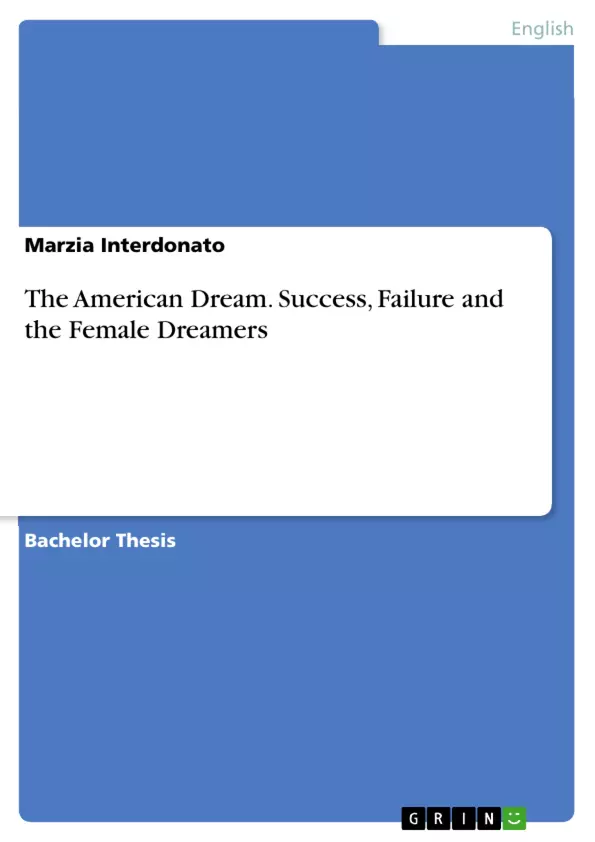In this work, what will be analyzed is the evolution over time of the famous phenomenon known as the American Dream. The next three chapters will mainly focus on whether or not the dream led more immigrants to success or failure, and also paying particular emphasis to how the dream was and is interpreted by most of the women living the American Dream.
This work is divided into three chapters, starting from the discovery of the continent where the dream is best associated: the United States of America. Secondly, understanding the meaning of the term ‘American Dream’, its formation and who has used it throughout the course of its history. It will also focus on how the dream will be analyzed in a more current twentieth century context and understanding, nevertheless assessing the female dreamers through close analysis of a novel and a poem.
People have always had dreams. We could acknowledge that today’s dreams might be unrealistic because of corruption, however, the dreams that people had in the past were of a different nature. Success only meant having the bare necessities: a job, food for your family, new clothes a couple of times a year, a house or an apartment, and maybe even enough money to commute by transit. Achieving this success, implied much struggles, sacrifice and hard work.
Looking back at the scenario, it appears to have been a very harsh experience for those who had immigrated to America. As a result of the many sacrifices that were made in pursuit of their own personal and familial goals; such as monetary success and a better life of freedom and opportunity for their descendants. Their goals consisted of only the basic life values such as personal freedom through equal rights and opportunity that we today consider to not only be essential to life, but entitlements. Thanks to the millions of hard-working immigrants, and the hundreds of thousands of soldiers and protestors who have died in the name of democracy and the rights and freedoms that today allow us to live a better life: in pursuit of their own personal and familial goals, it was the first immigrants to America who also helped build and sustain what is today a global economic and military powerhouse and international authority – the United States of America.
Inhaltsverzeichnis (Table of Contents)
- Introduction
- Chapter 1: The Roots of the American Continent
- 1.1 The Native American Tribe
- 1.2 First practical idea of the discoveries of America
- 1.3 The English Colonial period
- 1.4 The Land of possibilities
- 1.5 The contrasts in reaching the dreamland
- Chapter 2: Analyzing the American Dream
- 2.1 "Dreaming"
- 2.2 The birth of the terminology “the American Dream”
- 2.3 The possible definition
- 2.4 The wide spreading of its creation.
- 2.5 The exploration of the American dream through Crèvecœur.
- 2.6 Crèvecœur's distorted vision of the dream
- 2.7 Dream turning into nightmares
- Chapter 3: The female Dreamer
- 3.1 Towards the Expansion
- 3.2 The power of Women.
- 3.3 The modern woman: the Flapper
- 3.4 The American Dreamer: F. Scott Fitzgerald
- 3.5 Analyzing The Great Gatsby
- 3.6 The Utopian couple: Gatsby and Daisy .
- 3.7 The feminine's presence in the Great Gatsby
- 3.8 Ruth Forman: today's dream
- 3.9 Analyzing Stoplight Politics
- 3.10 The Relationship of the two works
Zielsetzung und Themenschwerpunkte (Objectives and Key Themes)
This work analyzes the phenomenon of the American Dream: its birth, development and evolution up to the present day. The chosen works to achieve this goal are The Great Gatsby, written by F. Scott Fitzgerald, and the poem and song Stoplight Politics by Ruth Forman, both united by the same theme of the American Dream.
- Historical roots and development of the American Dream
- The concept of the American Dream and its definition
- The evolution of the American Dream and its complexities
- The role of women in the pursuit of the American Dream
- The American Dream as a concept in literature and popular culture
Zusammenfassung der Kapitel (Chapter Summaries)
Chapter 1 explores the history of the American continent, focusing on the arrival of the first settlers, the impact of Christopher Columbus’ discovery, and the subsequent English colonial period. It highlights the transition from Native American tribes to a land of opportunity and the allure of the American Dream for European immigrants. Chapter 2 delves into the terminology and definition of the "American Dream," exploring its origins, the evolution of its meaning, and its impact on different groups. The chapter examines various interpretations and analyzes the work of Saint John de Crèvecœur to understand the potential pitfalls and distortions of this dream. Chapter 3 focuses on the female perspective of the American Dream, examining its manifestation in literature and popular culture. This chapter explores the aspirations and experiences of women in pursuit of their own American Dream, using the works of F. Scott Fitzgerald and Ruth Forman as examples. The chapter emphasizes the portrayal of wealth and status as elements of the American Dream, highlighting the complexities and contradictions associated with this ideal.
Schlüsselwörter (Keywords)
The American Dream, American history, European immigration, Native American tribes, colonial period, land of opportunity, social mobility, economic prosperity, Crèvecœur, Fitzgerald, The Great Gatsby, Forman, Stoplight Politics, women’s perspectives, social status, wealth, modern America, cultural representation.
- Citar trabajo
- Marzia Interdonato (Autor), 2011, The American Dream. Success, Failure and the Female Dreamers, Múnich, GRIN Verlag, https://www.grin.com/document/318863



